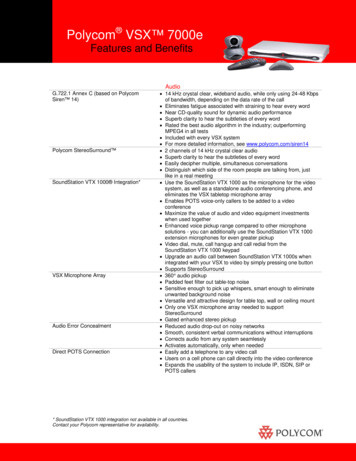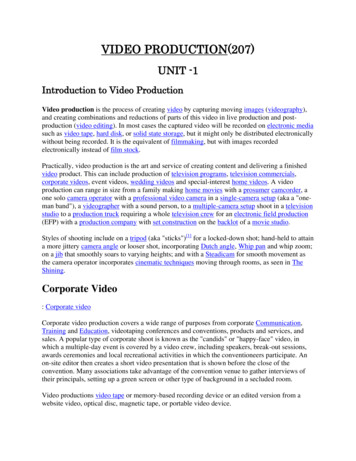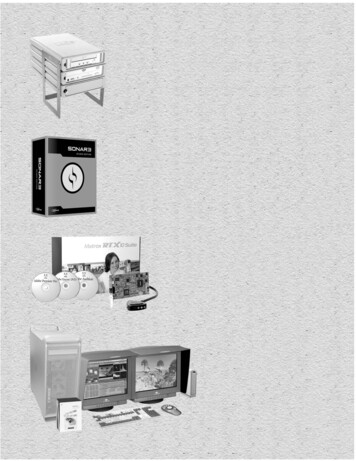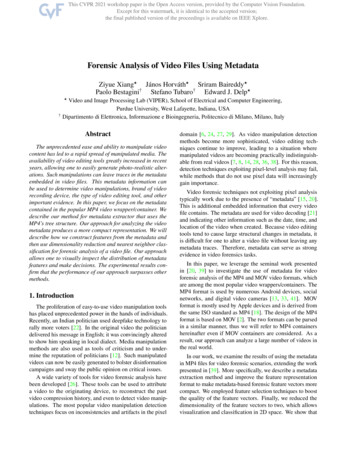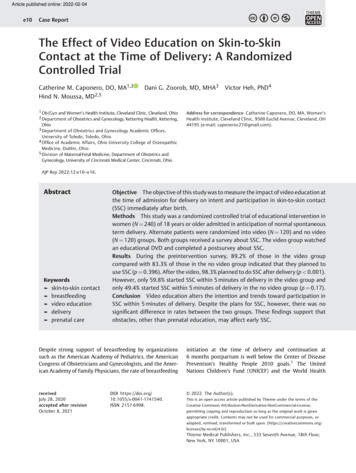
Transcription
Article published online: 2022-02-04THIEMEe10Case ReportThe Effect of Video Education on Skin-to-SkinContact at the Time of Delivery: A RandomizedControlled TrialCatherine M. Caponero, DO, MA1,2Hind N. Moussa, MD2,5Dani G. Zoorob, MD, MHA31 Ob/Gyn and Women’s Health Institute, Cleveland Clinic, Cleveland, Ohio2 Department of Obstetrics and Gynecology, Kettering Health, Kettering,OhioVictor Heh, PhD4Address for correspondence Catherine Caponero, DO, MA, Women’sHealth Institute, Cleveland Clinic, 9500 Euclid Avenue, Cleveland, OH44195 (e-mail: caponeroc27@gmail.com).3 Department of Obstetrics and Gynecology Academic Offices,University of Toledo, Toledo, Ohio4 Office of Academic Affairs, Ohio University College of OsteopathicMedicine, Dublin, Ohio5 Division of Maternal-Fetal Medicine, Department of Obstetrics andGynecology, University of Cincinnati Medical Center, Cincinnati, OhioAJP Rep 2022;12:e10–e16.AbstractKeywords skin-to-skin contactbreastfeedingvideo educationdeliveryprenatal careObjective The objective of this study was to measure the impact of video education atthe time of admission for delivery on intent and participation in skin-to-skin contact(SSC) immediately after birth.Methods This study was a randomized controlled trial of educational intervention inwomen (N ¼ 240) of 18 years or older admitted in anticipation of normal spontaneousterm delivery. Alternate patients were randomized into video (N ¼ 120) and no video(N ¼ 120) groups. Both groups received a survey about SSC. The video group watchedan educational DVD and completed a postsurvey about SSC.Results During the preintervention survey, 89.2% of those in the video groupcompared with 83.3% of those in the no video group indicated that they planned touse SSC (p ¼ 0.396). After the video, 98.3% planned to do SSC after delivery (p 0.001).However, only 59.8% started SSC within 5 minutes of delivery in the video group andonly 49.4% started SSC within 5 minutes of delivery in the no video group (p ¼ 0.17).Conclusion Video education alters the intention and trends toward participation inSSC within 5 minutes of delivery. Despite the plans for SSC, however, there was nosignificant difference in rates between the two groups. These findings support thatobstacles, other than prenatal education, may affect early SSC.Despite strong support of breastfeeding by organizationssuch as the American Academy of Pediatrics, the AmericanCongress of Obstetricians and Gynecologists, and the American Academy of Family Physicians, the rate of breastfeedinginitiation at the time of delivery and continuation at6 months postpartum is well below the Center of DiseasePrevention’s Healthy People 2010 goals.1 The UnitedNations Children’s Fund (UNICEF) and the World HealthreceivedJuly 28, 2020accepted after revisionOctober 8, 2021 2022. The Author(s).DOI https://doi.org/10.1055/s-0041-1741540.ISSN 2157-6998.This is an open access article published by Thieme under the terms of theCreative Commons rmitting copying and reproduction so long as the original work is givenappropriate credit. Contents may not be used for commercial purposes, oradapted, remixed, transformed or built upon. /)Thieme Medical Publishers, Inc., 333 Seventh Avenue, 18th Floor,New York, NY 10001, USA
The Effect of Video Education on Skin-to-Skin ContactCaponero et al.Key Points Significant obstacles impact skin-to-skin rate.Video education alters skin-to-skin intent.Video education can improve skin-to-skin rate.Education can happen at the time of delivery.Video education can impact mothers and infants.Organization (WHO) have estimated that if all infantswere breastfed for a minimum of the first 6 months oftheir lives, the rate of morbidity and malnutrition wouldsignificantly decrease across the world.2 As a result,WHO and UNICEF launched the Baby-Friendly HospitalInitiative (BFHI) in 1991 to encourage proper infant feedingpractices starting at birth. The initiative includes 10 stepswhich hospitals must meet to obtain and maintain certification. Step 4 of the BFHI aims to “help mothers initiatebreastfeeding within 1 hour of birth,” and skin-to-skincontact (SSC) between mother and infant within 5 minutesis encouraged and set as the standard criteria in support ofthis goal.3Skin-to-skin, otherwise known as SSC, on a mother’s chestimmediately following birth provides thermoregulation,physiological stability, appropriate stimulation for the infant, and encourages bonding and breastfeeding.4 Previouswork demonstrates that early SSC is positively associatedwith breastfeeding from discharge through 3 months postpartum.5 However, there are significant obstacles to SSC andbreastfeeding including insufficient prenatal education, disruptive obstetrical practices, and a lack of family and societalsupport.6 These barriers are more prevalent among vulnerable groups such as black, low income, or poorly educatedpopulations.2 Delivery room practices and postpartum hospital routines may also hinder initiation of SSC if not part ofthe standard care protocols and thus significantly disruptearly maternal–infant interactions.7 While initiatives such asBFHI may combat some of these obstacles, guidelines forprimary care-based interventions originating in a clinician’soffice currently do not exist.8In this study, we sought to evaluate the impact of prenatalvideo education on both pregnant women’s intention as wellas the actual rate of practicing SSC after birth. We hypothesized that by providing SSC education in an easily comprehensible and patient-friendly video format shortly beforedelivery would encourage participation in SSC immediatelyupon delivery. This timing would allow the topic to beremembered clearly and would allow patients to engage inan active dialogue with the staff who will be preforming thedelivery.9 The goal of educating mothers was not only toincrease their knowledge and skills but also to influence theirattitudes toward accepting early SCC.10 By providing a videowhich models SSC to all nonemergent anticipated vaginaldeliveries upon admission to the hospital, our hope was toencourage patients to actively participate in SSC at the timeof delivery and become their own advocates for such apractice.Materials and MethodsPatient SelectionStudy participants were recruited at the time of admission tolabor and delivery by an obstetrics and gynecology residentat Southview Medical Center. Patients met inclusion criteriafor this study if they were admitted with anticipation of anormal spontaneous vaginal delivery within 1 week of thetime of admission, were more than 37 weeks of gestationalage, fluent in spoken English, and older than 18 years.Patients who did not meet the aforementioned criteria orwho were unstable medically at the time of delivery wereexcluded from the study.Study DesignFollowing recruitment, patients were immediately randomized into no video (Group A—control) and video groups (GroupB—experimental). Patients assigned to Group B watched avideo titled “Jumping into Kangaroo Care” developed by theOhio Department of Health. The video is 8 minutes and52 seconds in length. It discusses the benefits and logistics ofkangaroo care, a commonly used methodology for educationand awareness related to SSC, from both the professional andnew mother’s perspectives.Randomization occurred in the order that the patient wasenrolled in the study. The first patient enrolled was in GroupA and asked a presurvey regarding: their intention to practice SSC at the time of deliveryif they participated in SSC in a previous pregnancyif they had any formal training about SSCand if they did have formal training, was it eitherprovided at a prenatal appointmentor a formal class led by either a nurse or a lactationconsultantThe second patient enrolled was in Group B and tookthe same presurvey, watched the “Jumping into KangarooCare” video, and then took the postsurvey which asked ifthey intended to practice SSC at the time of delivery. Thethird patient enrolled would take only the presurveyand be in Group A, etc. The complete survey is shownin Appendix A .This project was approved by the Institutional ReviewBoard at Kettering Health Network prior to registration withClinicalTrials.gov (study number NCT03200925).Outcome MeasuresOur primary outcome of interest was the intent to participate in SSC following delivery. Our secondary outcome wasAmerican Journal of Perinatology ReportsVol. 12No. 1/2022 2022. The Author(s).e11
e12The Effect of Video Education on Skin-to-Skin ContactCaponero et al.participation in SSC within 5 minutes of delivery. To identifysignificant differences in time until start of SSC, this variablewas dichotomized to “within 5 minutes” and “after5 minutes.”Data CollectionFor each participant, we collected data on patient age, gestational age at enrollment, pregnancy comorbidities, race, type ofinsurance, and the number of times the patient has beenpregnant. We also collected the neonate’s 5-minute Apgar score,delivery date/time, SSC initiation time, SSC end time, delivery toSSC duration (in minutes), and SSC duration (in minutes). Finally,we determined if SSC was not initiated because of new-onsetincreased level of fetal or maternal acuity of care, or if themother declined/elected not to proceed with SCC. These datawere obtained through routine nursing documentation as apartof standard workflow. If a participant delivered with a 5-minuteApgar less than 7 or required a cesarean delivery, the patient wasnot included in data collection regarding SSC at the time ofdelivery. Since the primary outcome was intent to perform SCC,analysis was performed for this group only on this basis and noton actual implementation of SCC.Statistical AnalysisSample Size CalculationIn the quarter prior to this study, Southview Medical Centerhad established that the institutional baseline of SSC was 50%for eligible vaginal deliveries (i.e., more than 37 weeks’gestation with a 5-minute Apgar of 7). The BFHI had set agoal for the hospital to achieve 82% rate of SSC.We employed planned interim analysis based on a recruitment goal of 240 patients and adopted “two looks” atthe data to determine statistical significance. This was completed by our statistician who was blinded to the studyparticipants. The first look occurred after recruiting 120women (60 per group) and the second look after reachingthe goal of 240 women (120 per group). We used cutoffpoints of z ¼ 3.5 for first look and z ¼ 2.0 for second look.11Hypothetically, 50% of Group A and 80% of Group B intendedto participate in SSC (30% difference in proportion) duringthe first interim analysis, 50% interim sample size (120patients) would result in an absolute z-statistics of 4.89,and data collection would have ended. However, given oursmaller difference in proportions on first look, data collection was continued until 240 patients were recruited to reachstatistical significance.Descriptive characteristics were presented as mean( standard deviation) for continuous data and samplesize (percentage) for categorical data. Continuous variableswere compared using z-test and categorical variableswere compared using chi-square test. Dichotomous outcomes were further analyzed using logistic regression withadjustment for clinically and statistically significant variables. All statistical tests were two sided, power of 80%, andp-values less than 0.05 were considered statistically significant. SPSS (IBM Corp.) version 22 was used for dataanalysis.American Journal of Perinatology ReportsVol. 12No. 1/2022 2022. The Author(s).ResultsIntention to Participate in SSC before and after VideoEducationThere were no significant differences between the tworandomized groups of patients in terms of baseline characteristics such as demographics, comorbidities, and obstetricmeasures ( Table 1). Most respondents in both groupsindicated that they planned to use SSC after delivery. Thepreintervention survey showed that there was no differencein intent to use SSC between the two groups with 89.2%(n ¼ 107/120) of the video group indicating intent to use SSCcompared with 83.3% (n ¼ 100/120) of the no video group(p ¼ 0.396) ( Fig. 1). However, after watching the video, thepercentage of patients intending to use SSC after deliveryincreased to 98.3% (118/120; p 0.001) ( Table 2).Effect of Video Intervention on Time from Delivery toStart of SSCOf the 240 patients included in the study, 63 patientsproceeded to cesarean section or did not complete SSC dueto increased fetal/maternal acuity of care, or maternal refusal. As such, 177 (73.8%) were included in the analysis for timeto SSC per se ( Fig. 1). The video group trended towardinitiating SSC within 5 minutes of delivery at 59.8%(n ¼ 55/92) compared with the rate in the no video groupof 49.4% (n ¼ 42/85) (p ¼ 0.17).Effect of Prior Formal Education by Physician/Nurse/Lactation Consultant on Time to SSCOf the 177patients, 58 (32.8%) reportedformal education beforethey were included in the study, and 119 (67.2%) did not reportany formal education ( Table 2). The proportion of those whoreported formal education beforehand started SSC within5 minutes was 62.1% (n ¼ 36/58), while in those who did notreport formal education, it was 51.3% (n ¼ 61/119) (p ¼ 0.18).A subanalysis was performed for only those who did nothave any formal education before joining the study (n ¼ 119).This demonstrated that a greater proportion of patients inthe video group who initiated SSC within 5 minutes ofdelivery compared with those in the no video group (59.7%[n ¼ 37/62] vs. 42.1% [n ¼ 24/57], p ¼ 0.04).CommentsPrincipal Findings/ResultsIn this study, we found that the video education interventionincreased intent to perform SSC in pregnant patients receiving that education upon their delivery hospitalization. Furthermore, SCC completion rates were increased after thatvideo education in women who did not perceive having priorformal education about SCC during their pregnancy. To date,this is the only study that examines the impact of educationat that time on intent and implementation of SCC.Clinical ImplicationsIf we consider efforts made to improve breastfeeding rates,we see that patient education programs have the single
The Effect of Video Education on Skin-to-Skin ContactCaponero et al.Table 1 Patient characteristics and obstetric measures for those who did and did not receive video training on SSCVideo group, N ¼ 120No video group, N ¼ 120p-ValueAge, mean (SD)27.0 (5.1)27.1 (5.5)0.9Primiparous, n (%)55 (45.8)53 (44.2)0.8Patient CharacteristicsDemographicCaucasian, n (%)98 (81.7)90 (75.0)0.21Private insurance, n (%)58 (48.3)55 (45.8)0.92Medicaid, n (%)58 (48.3)61 (50.8)Chronic hypertension, n (%)3 (2.5)5 (4.2)0.47Gestational hypertension, n (%)10 (8.3)6 (5.0)0.3Preeclampsia, n (%)2 (1.7)3 (2.5)0.65Gestational diabetes mellitus, n (%)9 (7.5)4 (3.4)0.16Asthma, n (%)10 (8.3)10 (8.3)1Neurologic disease, n (%)1 (0.8)4 (3.8)0.18ComorbiditiesHematologic disease, n (%)9 (7.5)13 (10.8)0.37Other comorbidities, n (%)42 (35.0)40 (33.3)0.79Spontaneous vaginal delivery, n (%)89 (74.2)84 (70.0)0.77Vacuum delivery, n (%)9 (7.5)11 (9.2)0.82Low transverse cesarean delivery, n (%)22 (18.3)25 (20.8)0.75Gestational age in wk, mean (SD)39391.005-min Apgar, median9 (8, 10)9 (7, 9)0.16Obstetric measuresAbbreviations: SD, standard deviation; SSC, skin-to-skin contact, median (minimum, maximum).greatest effect of any single intervention on both initiationand short-term duration for breastfeeding.8 For example,women who attend breastfeeding classes with lactationconsultants are more likely to continue breastfeeding at6 months when compared with controls.1Although 91% of the cohort “planned” to initiate SSCimmediately after delivery, only 60% of eligible individualsin the video group started SSC within 5 minutes of deliveryand only 50% started SSC in the no video group followed suit.Women without prior formal education about SCC weremore likely to initiate SSC within 5 minutes of delivery afterthe video education intervention during the delivery hospitalization. However, the “lower than planned” rates likelyoccurred due to barriers to SSC independent of patienteducation, including but not limited to staff education andthe clinical culture.Patient education can easily influence behaviors withoutrequiring substantial effort on behalf of providers, anddifferent options must be considered when attempting toimprove SSC rates.9 Currently, common office practicesinclude provision of written materials and discharge packets.However, neither practice effectively increases rates ofbreastfeeding, and discharge packets have even reported toactually reduce the rates of breastfeeding.8 As such, writtendocuments would not likely improve SSC rates. Ideally,antepartum appointments should include education on thebenefits of both breastfeeding and SSC.8 However, in a busyclinic setting with a vulnerable patient population, theability to provide extra educational classes is not alwaysan option, and this study demonstrates the alternativeoption of video education at the time of delivery. Theworking premise is that by watching the video shortly beforedelivery, patients will have the topic of SSC fresh in theirminds when it comes time to decide on how to interact withthe neonate. Video intervention may also be an effectiveapproach for other perinatal interventions, including breastfeeding, diet/exercise, immunizations, and smokingcessation.As demonstrated in this study, video education has thepotential to not only inform but also effect change. Video hasthe capability to present a lot of complex information in arapid, simple, and clear manner.12,13 One study found thatpatients who viewed videotapes that discussed treatmentoptions had a greater understanding of the risks and benefitsof those choices and were more apt to be active participantsin decision-making.12 Audio-visual material can also beuseful for those who have limited literacy skills. Moreover,the information provided to patients in video format has theadvantage of being consistent when repeated, which allowspractitioners to provide the same information to allpatients.14 This type of intervention is ideal for the perinatalsetting given the need to provide accurate information in aconcise, expeditious, and standardized manner that appliesto the majority of pregnant patients.American Journal of Perinatology ReportsVol. 12No. 1/2022 2022. The Author(s).e13
e14The Effect of Video Education on Skin-to-Skin ContactCaponero et al.Fig. 1 CONSORT diagram. SSC, skin-to-skin contact.Table 2 Outcome measures for those who did and did not receive video training on SSCOutcome measuresVideo group,N ¼ 120No video group,N ¼ 120p-ValueSSC intention pre, yes, n (%)107 (89.2)100 (83.3)0.19SSC intention post, yes, n (%)118 (98.3)––Prior formal education about SSC38 (31.7)40 (33.3)0.78Patients studied for initiation of SSCn ¼ 92n ¼ 850.17Delivery to SSC in min, median3 (0, 26)6 (0, 39)0.19SSC duration in min, median91 (13, 210)88 (17, 161)0.88Abbreviations: SD, standard deviation; SSC, skin-to-skin contact, median (minimum, maximum).Research ImplicationsLimitations and StrengthsWith SSC implemented at a less than planned rate, futurestudies should involve other barriers including staff andfamily education. Timing of education in other settings aswell, such as throughout prenatal care or in groupprenatal care models, could also be considered in futurestudies.This study has several limitations and strengths that areworth noting. One limitation was that we could not controlpatients’ previous exposure to SSC training, nor the influence of delivery room personnel including physicians, nursing staff, respiratory therapists, residents, students, andpatient’s families on initiation of SSC. This, however, isAmerican Journal of Perinatology ReportsVol. 12No. 1/2022 2022. The Author(s).
The Effect of Video Education on Skin-to-Skin Contactconsistent with standard clinical practice and thus our population can reflect the normal population with similar characteristics. Another limitation was that the time to SSC analysiswas limited to healthy infants with Apgar greater than 7,vaginal deliveries, and infants being born after 37 weeks,and as such it is notable that many patients were not able tohave their intentions fulfilled. We also utilized a pragmaticdesign for randomization; however, the data show that thegroups were statistically similar. Importantly, this trial hasseveral strengths. The first is that it is a randomized controlledtrial with statistically similar groups. The second is that afteran extensive PubMed search, no other studies were found thatexamined the impact and timing of patient education on SSC.Authors’ ContributionC.M.C., is the project lead and manuscript initial write-up;D.G.Z. contributed in manuscript editing; V.H. contributed in statistics; and H.N.M. is the mentor and facultyadvisor, manuscript write-up.Conflict of InterestNone declared.References1 Rosen IM, Krueger MV, Carney LM, Graham JA. Prenatal breast-2ConclusionThrough this randomized controlled study, we can concludethat video education at the time of admission improves apatient’s intent to participate in SSC. These findings supportthat additional barriers, other than prenatal education, mayaffect a patient’s completion of SSC. In women without perceived prior education about SSC, the video intervention wassuccessful in improving SSC rates. That said, this study providesan easily implementable tool that can motivate new mothersto engage in evidence-driven practice with the potential toimprove both mother and infant well-being.Oral PresentationsACOG Districts V&VII Annual Meeting on Sunday, September 23, 2018, in Kansas City, MO; The ACOOG 86th AnnualConference on Thursday, March 28, 2019, in New Orleans,LA; and The First Annual Network Research Symposium onFriday, May 3, 2019, in Kettering, OH.Poster PresentationsThe ACOOG 86th Annual Conference on Monday, March 25,2019, in New Orleans, LA; DAGMEC 20th Annual Virginia C.Wood Resident Research Forum on Thursday, April 25,2019, in Dayton, OH; The First Annual Network ResearchSymposium on Friday, May 3, 2019, in Kettering, OH; andThe 2019 ACOG Annual Clinical and Scientific Meeting onSunday, May 5, 2019, in Nashville, TN.Poster Publication2019 MEFACOOG Annual Report.Clinical Trial T03200925Caponero et al.34567891011121314feeding education and breastfeeding outcomes. MCN Am J MaternChild Nurs 2008;33(05):315–319Burgio MA, Laganà AS, Sicilia A, et al. Breastfeeding education:where are we going? A systematic review article. Iran J PublicHealth 2016;45(08):970–977Baby-Friendly USA. “Guidelines and Evaluation Criteria for FacilitiesSeeking Baby-Friendly Designation.”. Albany, NY: Baby-Friendly USA;2016Charpak N, Ruiz JG. Latin American Clinical Epidemiology Network Series - Paper 9: the kangaroo mother care method: fromscientific evidence generated in Colombia to worldwide practice. JClin Epidemiol 2017;86:125–128Vila-candel R, Duke K, Soriano-vidal FJ, Castro-sánchez E. Affect ofearly skin-to-skin mother-infant contact in the maintenance ofexclusive breastfeeding: experience in a health department inSpain. J Hum Lact 2018;34(02):304–312Chung M, Raman G, Trikalinos T, Lau J, Ip S. Interventions in primarycare to promote breastfeeding: an evidence review for the U.S. Preventive Services Task Force. Ann Intern Med 2008;149(08):565–582Moore ER, Anderson GC, Bergman N. Early skin-to-skin contact formothers and their healthy newborn infants. Cochrane DatabaseSyst Rev 2007;(03):CD003519Guise JM, Palda V, Westhoff C, Chan BK, Helfand M, Lieu TAU.S.Preventive Services Task Force. The effectiveness of primary carebased interventions to promote breastfeeding: systematic evidence review and meta-analysis for the US Preventive ServicesTask Force. Ann Fam Med 2003;1(02):70–78Martínez-Galiano JM, Delgado-Rodríguez M. Influence of aneducation program of pregnant women on delivery. J MaternFetal Neonatal Med 2014;27(07):719–723Shealy KR, Li R, Benton-Davis S, Grummer-Strawn LM. The CDC Guide toBreastfeeding Interventions. Atlanta: U.S. Department of Health andHuman Services, Centers for Disease Control and Prevention; 2005O’Brien PC, Fleming TR. A multiple testing procedure for clinicaltrials. Biometrics 1979;35(03):549–556Krouse HJ. Video modelling to educate patients. J Adv Nurs 2001;33(06):748–757Hurtubise L, Martin B, Gilliland A, Mahan J. To play or not to play:leveraging video in medical education. J Grad Med Educ 2013;5(01):13–18Abu Abed M, Himmel W, Vormfelde S, Koschack J. Video-assistedpatient education to modify behavior: a systematic review.Patient Educ Couns 2014;97(01):16–22American Journal of Perinatology ReportsVol. 12No. 1/2022 2022. The Author(s).e15
e16The Effect of Video Education on Skin-to-Skin ContactCaponero et al.Appendix A Survey questions for: the effect of video education on skin-to-skin contact at the time of deliverySurvey questions asked at the timeof admission by both Groups A þ BDo you plan on participating in skin-to-skin contact immediately after delivery?a. Yesb. Noc. I do not knowHave you participated in skin-to-skin contact in a previous delivery?a. Yesb. Noc. I do not knowd. I have never had an infant beforeHave you had formal education about skin-to-skin contact?a. Yesb. NoIf completed formal education, was it eithera. Provided at a prenatal appointment by a physician or nurseb. A formal class led by either a nurse or a lactation consultantSurvey question asked to Group Bafter video educationAmerican Journal of Perinatology ReportsVol. 12Do you plan on participating in skin-to-skin contact immediately after delivery?a. Yesb. Noc. I do not knowNo. 1/2022 2022. The Author(s).
Catherine M. Caponero, DO, MA1,2 Dani G. Zoorob, MD, MHA3 Victor Heh, PhD4 Hind N. Moussa, MD2,5 1Ob/Gyn and Women's HealthInstitute,Cleveland Clinic,Cleveland, Ohio 2Department of Obstetrics and Gynecology, Kettering Health, Kettering, Ohio 3Department of Obstetrics and Gynecology Academic Offices, University of Toledo, Toledo, Ohio





